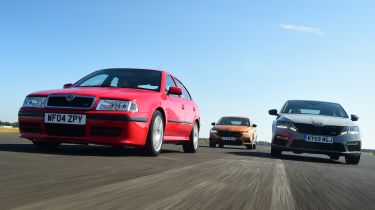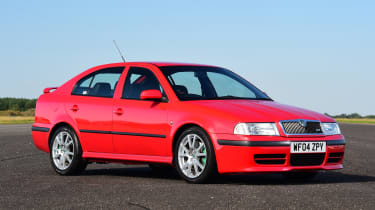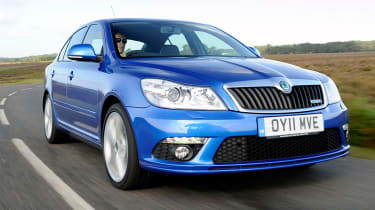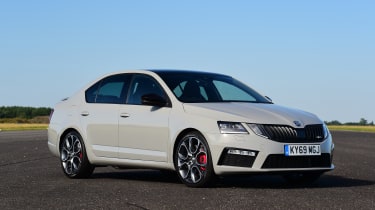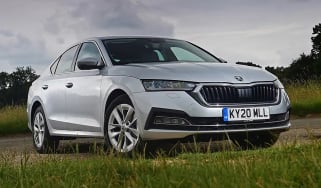Skoda Octavia vRS megatest: every model driven
From the original in 1998 to today's Mk4, we hit the road in all four Skoda Octavia vRS models...
When the Skoda Octavia was launched in the UK in 1998, it was the Czech brand's first new model under Volkswagen ownership. Even back then, VW’s big ambitions for Skoda were clear to see because it didn't stop there. Skoda also tried its hand at creating a performance sub-brand - the result was the Skoda Octavia vRS.
There was considerable motorsport heritage at Skoda to underpin this venture into the fast road car world: as recently as 1996, the brand had finished a remarkable third in the RAC Rally, with legendary driver Stig Blomquist at the wheel of a Felicia Kit Car. The Felicia was replaced the following year by – you guessed it – the Octavia itself.
Skoda’s sporty sub-brand was originally known as RS, but this upset Ford in the UK, which had used the Rally Sport nomenclature for some time. The lowercase ‘v’, which stands for ‘victory’, was added to create something unique.
As part of our Octavia 25th anniversary celebrations, we drove all four Skoda Octavia vRS models back-to-back, so scroll down below to read our thoughts on each of these landmark cars in affordable performance…
Skoda Octavia vRS Mk1
The vRS branding was applied to the Octavia first. Sharing its tech with the VW Group once again had its advantages, and in this instance, it was the availability of some potent powertrains. The Octavia had the 1.8-litre, 20-valve turbo petrol unit that was used in everything from the Golf GTI to the Audi TT.
In the Octavia, the motor pumped out 178bhp. But it was more than simply a case of shoehorning a big engine under the bonnet. This model also gained bigger brakes, extra body strengthening, firmer shock absorbers and 15mm-lower springs, plus a new design of anti-roll bar.
Despite this, it still feels very relaxing by modern hot-hatch standards. The ride is forgiving, and there’s an appreciable level of body roll. It’s by no means lacking control; if anything, the set-up allows you to flow with a typical B-road better than its more modern equivalents. The turbocharged engine isn’t as responsive as the very latest performance units, but that boost brings with it strong mid-range acceleration and a sense of occasion all of its own. It’s paired with a five-speed manual gearbox, which is reasonably precise in its operation.
The subtlety to the styling is something that more modern hatches can learn from, too. Green brake callipers and a modest body kit aside, it’s a fairly understated look. The two-tone seats and smart three-spoke steering wheel can’t quite lift the dark cabin ambience, though.
The early vRS models are bound to be collectable at some point in the future, and while the ultra-high-milers go for less than £1,000, we’d aim to spend a little over double that to get a much less used example. We can’t see them getting any cheaper.
Skoda Octavia vRS Mk2
For the step up to the Mk2 vRS, the aim was to produce something that wasn’t necessarily the sharpest hot hatch, but one which combined a bit of fun with touring ability, yet more sophistication thanks to independent rear suspension. But the Mk2 car weighed 150kg more than its predecessor. Power took a useful step up to 197bhp – dropping the 0-62mph time to 7.3 seconds – and a DSG twin-clutch automatic gearbox was offered for the first time. There was even a diesel version available, which flaunted the sporty vRS looks while offering much stronger fuel efficiency.
Second-generation vRS models start from little more than the original cars and are more plentiful on the used market. Most have mileages comfortably into six figures, with smart, low-mileage petrol estate models creeping towards £9,000.
Skoda Octavia vRS Mk3
Skoda wanted to emphasise just how grown up the performance potential of the Mk3 really was giving the car its grand debut at the 2013 Goodwood Festival of Speed. Power took a useful hike to 239bhp by the time the facelifted model was revealed later in the model’s production run. A new electronically controlled differential kept all the torque in check, while a revised steering geometry was designed to give a more grown-up feel.
Many hot-hatch fans quite rightly rave about the Mk7 Golf GTI, but with this car sharing so much under the skin, it makes it an ideal choice if you want a slightly more practical hot hatch. It’s good fun to drive on the right road, and holds up fairly strongly on track.
The one exception is the diesel version. Despite promising much better fuel economy, the power delivery is very flat (even in the later 197bhp diesels), so there’s little incentive to use the rev range’s full potential. It didn’t quite fit the bill as a bona-fide hot hatch, although it looked the part, thanks to black exterior highlights and a chin spoiler.
Skoda Octavia vRS Mk4
As with the standard fourth-generation Octavia, the vRS’s design and technology mark the greatest improvement. The new shape certainly makes the current car look the most menacing, and lashings of Alcantara trim make it feel like a road racer inside.
On the move, it’s possible to feel a steering rack that has been returned to make its response both quicker and more precise. A plug-in hybrid version is also offered, which combines a 1.4-litre turbocharged petrol with a 118bhp electric motor. But as with the diesel options of its Mk3 predecessor, it’s too heavy and its powertrain not exciting enough to fit the hot- hatch bill. Treat the PHEV version as a rapid cruiser, however, and it starts to make a lot of sense.
Click here for our list of the best hot hatchbacks on sale right now...

